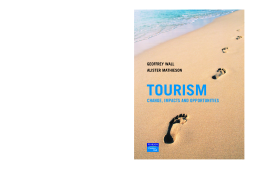
Additional Information
Book Details
Abstract
Tourism: Change, Impacts and Opportunities provides a comprehensive and balanced discussion of the impacts of tourism. The authors address the nature of tourism and tourists and the economic, physical and social impact that can result from their activity. New approaches to impact assessment are also considered. A wide range of examples from developed and developing countries illustrate the points raised in the text.
This timely and perceptive book is essential reading for anyone involved in tourism planning or development and is also suitable for students of geography, planning, economics and sociology.Table of Contents
| Section Title | Page | Action | Price |
|---|---|---|---|
| Cover | Cover | ||
| Tourism: change, impacts and opportunities | i | ||
| Contents | v | ||
| List of figures | viii | ||
| List of tables | ix | ||
| Preface | x | ||
| Acknowledgements | xii | ||
| Publisher’s acknowledgements | xiii | ||
| Introduction | 1 | ||
| Organization | 3 | ||
| Some research issues | 4 | ||
| Impact studies | 5 | ||
| Relationships between leisure, recreation and tourism | 8 | ||
| Definitions of tourism | 11 | ||
| Describing tourism: implications for impact assessment | 15 | ||
| Commentary | 17 | ||
| Frameworks | 19 | ||
| The dynamic element | 22 | ||
| The destination element | 33 | ||
| The consequential element | 38 | ||
| Tourist decision-making | 39 | ||
| Purchasing tourist products | 42 | ||
| The tourist profile | 44 | ||
| Spatial relationships | 49 | ||
| Summary and implications | 50 | ||
| Understanding change | 52 | ||
| Evolving perspectives | 54 | ||
| Spatial and temporal factors | 57 | ||
| Destination characteristics | 61 | ||
| Types of tourism | 62 | ||
| The state of knowledge | 62 | ||
| Factors contributing to and mediating impacts | 65 | ||
| Summary | 67 | ||
| Economic consequences | 68 | ||
| Economic characteristics of the tourism industry | 73 | ||
| Tourism and economic development | 77 | ||
| Advantages of tourism | 83 | ||
| Conditions for development | 85 | ||
| The realities of tourism and economic development | 88 | ||
| Economic benefits and costs | 89 | ||
| Tourism and the balance of payments | 90 | ||
| Currency flows | 102 | ||
| Tourism and national economic growth (gross domestic product or gdp) | 106 | ||
| Economic multipliers | 109 | ||
| Income generation and the distribution of tourist spending | 120 | ||
| Tourism and employment | 125 | ||
| Tourism and entrepreneurial activity | 136 | ||
| Tourism and economic structure | 141 | ||
| Economic impacts of special events and specific tourist industry activities | 143 | ||
| The economic costs of tourism | 145 | ||
| Economic indicators of the future of tourism | 150 | ||
| Summary | 152 | ||
| Environmental consequences | 154 | ||
| Tourism–environment relationships | 157 | ||
| Tourism and the environment: a symbiotic relationship | 160 | ||
| Tourism and environment in conflict | 168 | ||
| Impacts of tourism on ecosystems | 187 | ||
| Impacts of tourism on built environments | 195 | ||
| Tourism and competition for resources: tourism in rural areas | 213 | ||
| Conclusions | 217 | ||
| Social consequences | 220 | ||
| Tourist–host interrelationships | 223 | ||
| Social impacts of tourism | 226 | ||
| Framework for the measurement of social impacts | 227 | ||
| Tourism and social change: euphoria to xenophobia | 232 | ||
| Tourism and moral conduct | 242 | ||
| Tourism and religion | 250 | ||
| Tourism and language | 253 | ||
| Tourism and health | 255 | ||
| Summary | 258 | ||
| Cultural impacts | 259 | ||
| Tourism and cultural change | 263 | ||
| Intercultural communication | 267 | ||
| Culture as a commodity | 271 | ||
| Authenticity in the tourist experience | 271 | ||
| Tourism and material forms of culture | 272 | ||
| Tourism and non-material forms of culture | 280 | ||
| Conclusions | 284 | ||
| Sustainable developments | 288 | ||
| Sustainable development | 289 | ||
| The status of tourism planning and management | 293 | ||
| Points, lines and areas | 296 | ||
| Impact assessment and monitoring | 298 | ||
| Analysis versus involvement | 306 | ||
| Community-based tourism, stakeholders and partnerships | 307 | ||
| An evaluation triangle | 308 | ||
| Conclusions | 311 | ||
| Conclusions | 313 | ||
| Planning for tourist impacts | 316 | ||
| Impact research and planning | 317 | ||
| Summary | 324 | ||
| References and bibliography | 328 | ||
| Index | 390 |
